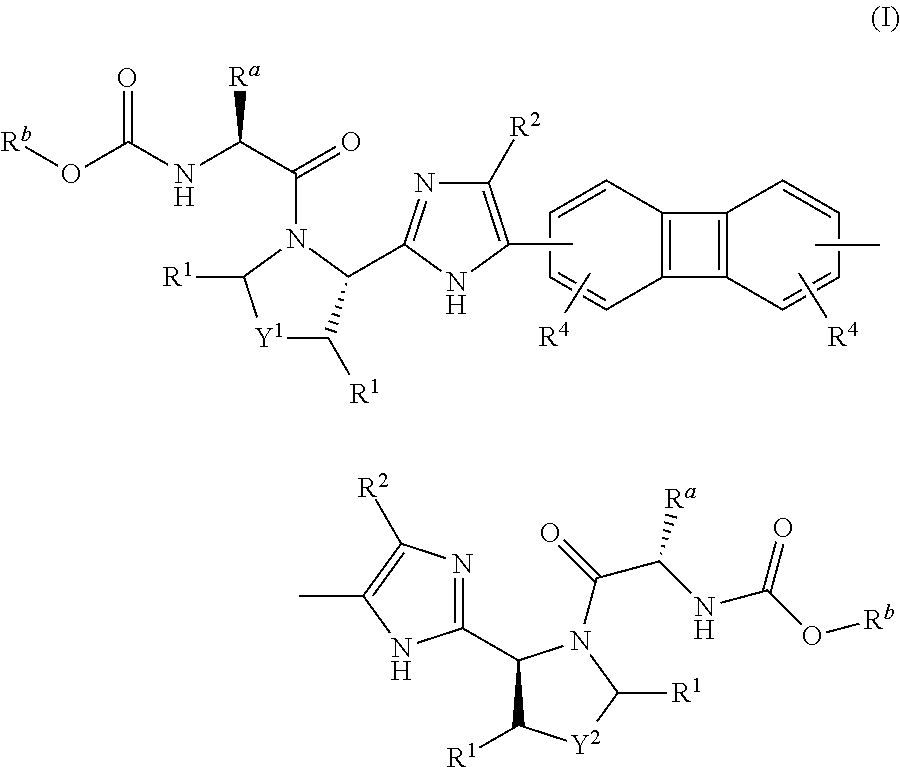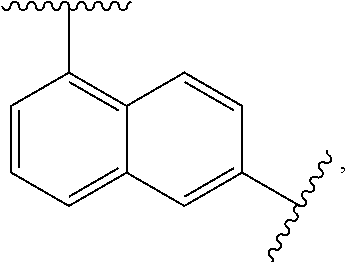Substituted biphenylene compounds and methods of use thereof for the treatment of viral diseases
a technology of substituted biphenylene and biphenylene, which is applied in the direction of group 3/13 element organic compounds, group 4/14 element organic compounds, drug compositions, etc., can solve the problems of unfavorable side effects, poor efficacy, and inability to cure viral diseases, so as to reduce the likelihood or severity of symptoms
- Summary
- Abstract
- Description
- Claims
- Application Information
AI Technical Summary
Benefits of technology
Problems solved by technology
Method used
Image
Examples
example 1
Preparation of Intermediate Compound Int-1b
[0165]
[0166]To a solution of L-valine (Int-1a, 10.0 g, 85.3 mmol) in 1M aqueous NaOH solution (86 mL) at room temperature was added solid sodium carbonate (4.60 g, 43.4 mmol). The reaction mixture was cooled to 0° C. (ice bath) and then methyl chloroformate (7.20 mL, 93.6 mmol) was added dropwise over 20 minutes. The reaction mixture was then allowed to warm to room temperature, and allowed to stir at room temperature for an additional 4 hours. The reaction mixture was then diluted with diethyl ether (100 mL), the resulting solution was cooled to at 0° C., and then concentrated hydrochloric acid (18 mL, 216 mmol) was added slowly. The reaction was extracted with EtOAc (3×100 mL) and the combined organics were dried over MgSO4, filtered and concentrated in vacuo to provide Compound Int-1b (13.5 g, 90%), which was used without further purification.
example 2
Preparation of Intermediate Compound Int-2f
Step A—Synthesis of Compound Int-2b
[0167]
[0168]Bis(chloromethyl)dimethylsilane (Int-2a, 50 g, 0.32 mol), sodium iodide (181 g, 1.21 mol), and dried acetone (1 L) were added to a 2-liter round-bottomed flask. The resulting suspension was heated to reflux and allowed to stir at this temperature for 3.5 hours, then allowed to cool to room temperature. The reaction mixture was then filtered, concentrated in vacuo, and the residue obtained was redissolved in ethyl acetate (500 mL). The resulting suspension was filtered and the filtrate was concentrated in vacuo to provide Compound Int-2b as an oil (90.5 g, 84%), which was used without further purification.
Step B—Synthesis of Compound Int-2d
[0169]
[0170](R)-2,5-Dihydro-3,6-dimethoxy-2-isopropylpyrazine (Int-2c, 25 g, 135.7 mmol) and dry THF (500 mL) were added to a dry 1-liter flask and the resulting solution was cooled to −78° C. under a nitrogen atmosphere. A solution of 2.5 M n-BuLi in hexane (...
example 3
Intermediate Compounds Int-3a to Int-3i
[0175]The following intermediate compounds are commercially available and useful for making the Compounds of Formula (I):
CompoundNo.Proline DerivativeInt-3aInt-3bInt-3cInt-3dInt-3eInt-3fInt-3gInt-3hInt-3i
PUM
| Property | Measurement | Unit |
|---|---|---|
| temperature | aaaaa | aaaaa |
| temperature | aaaaa | aaaaa |
| temperature | aaaaa | aaaaa |
Abstract
Description
Claims
Application Information
 Login to View More
Login to View More - R&D
- Intellectual Property
- Life Sciences
- Materials
- Tech Scout
- Unparalleled Data Quality
- Higher Quality Content
- 60% Fewer Hallucinations
Browse by: Latest US Patents, China's latest patents, Technical Efficacy Thesaurus, Application Domain, Technology Topic, Popular Technical Reports.
© 2025 PatSnap. All rights reserved.Legal|Privacy policy|Modern Slavery Act Transparency Statement|Sitemap|About US| Contact US: help@patsnap.com



